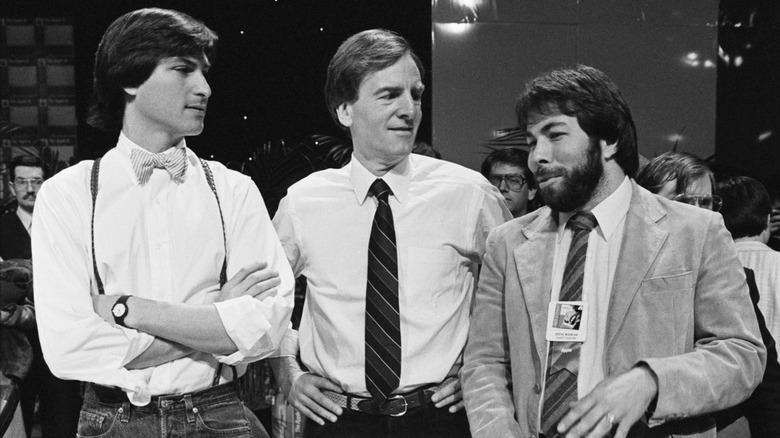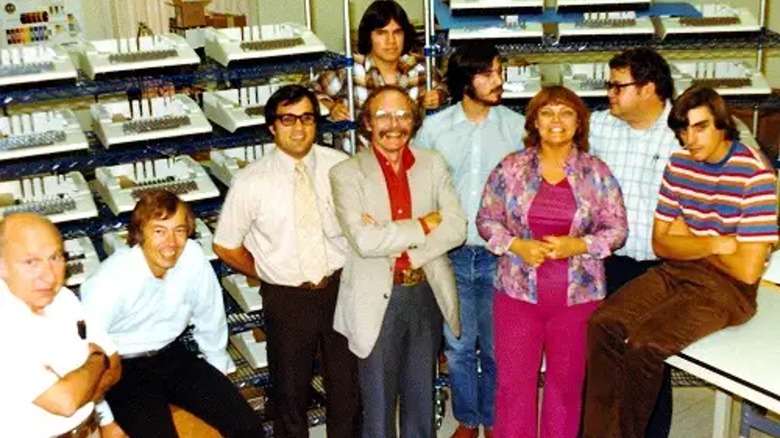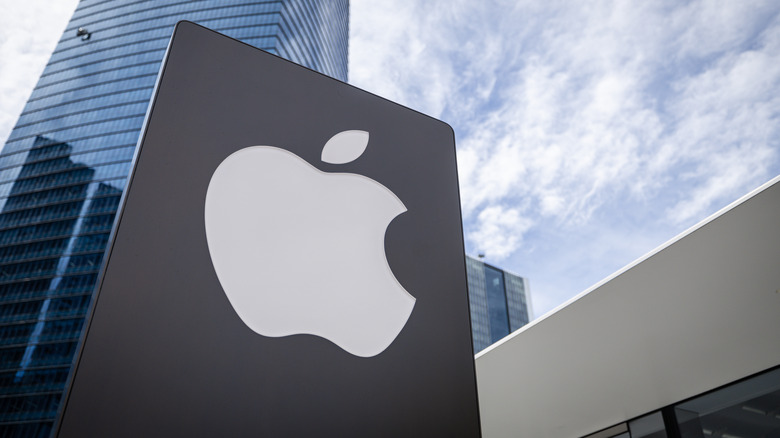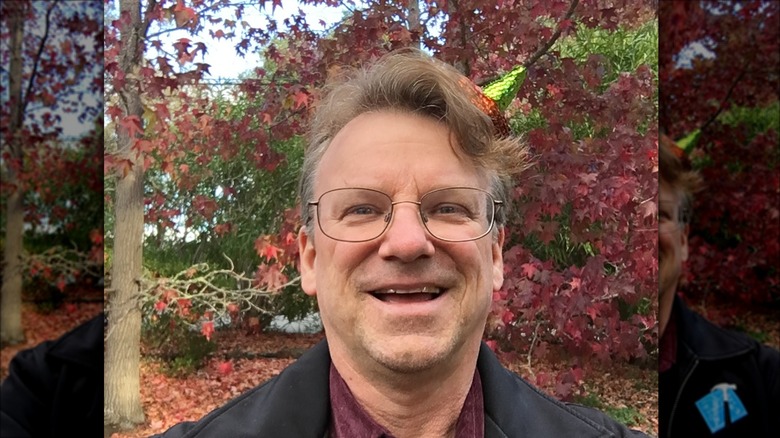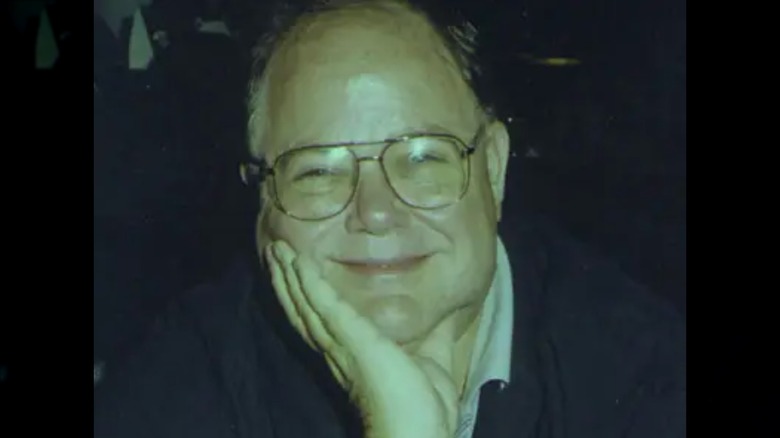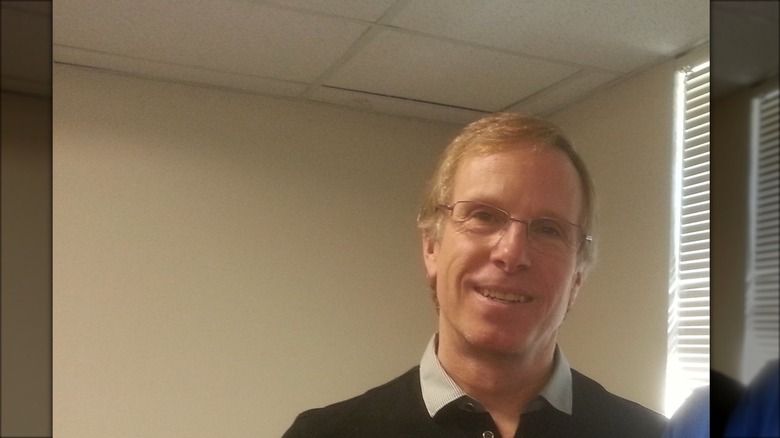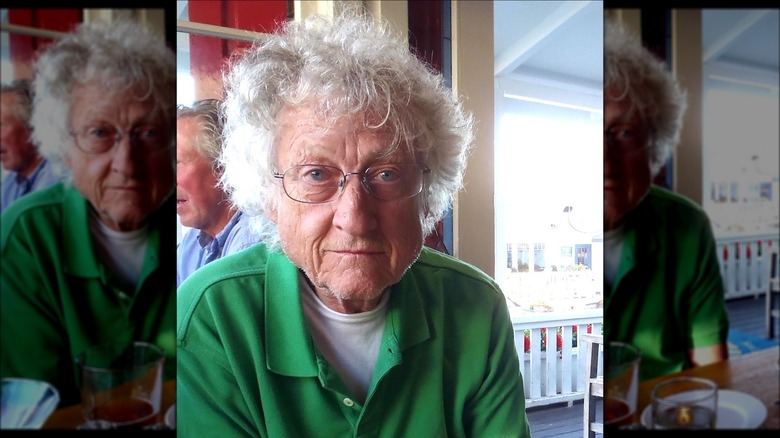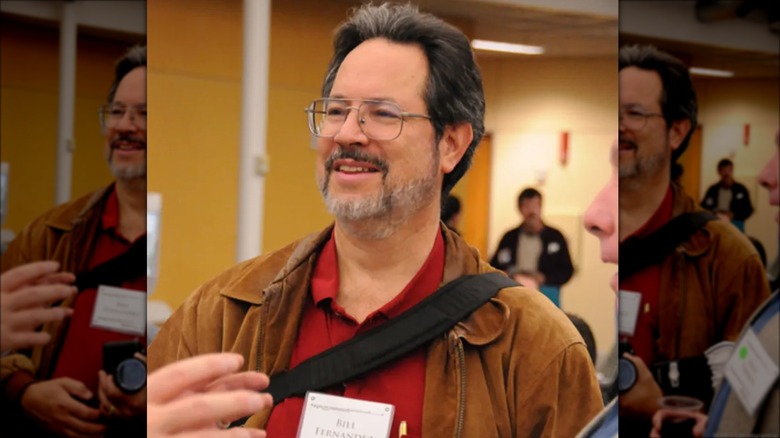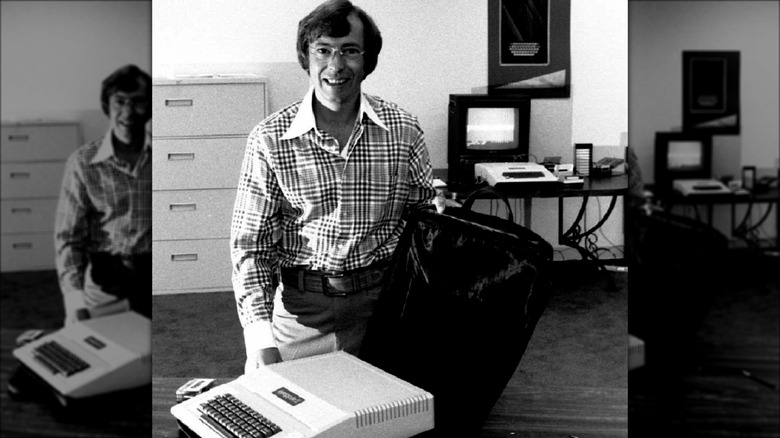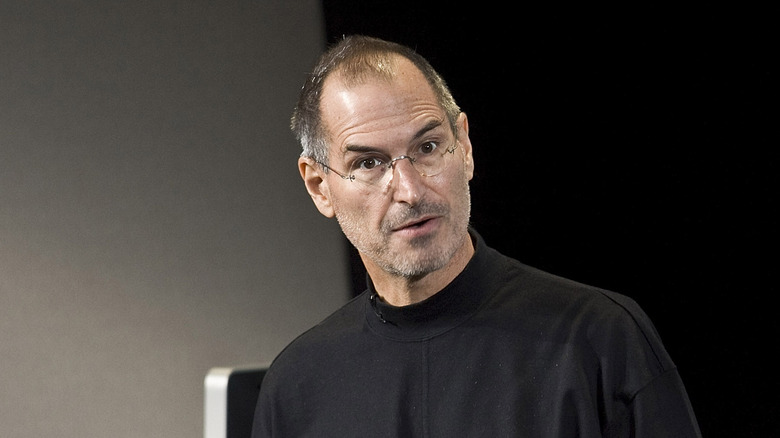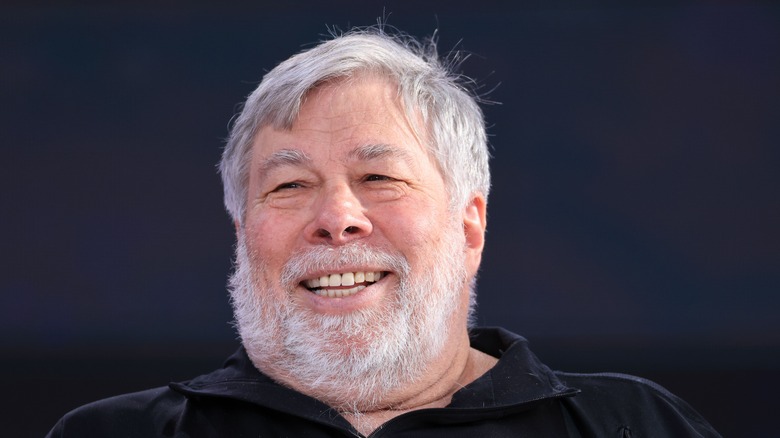Whatever Happened To Apple's First Employees
The story of Apple is one for the ages, and it's no surprise that the early leaders of the company have been firmly etched in corporate history. While Steve Jobs and Steve Wozniak are most often associated as the definitive faces of the company, it was actually the small band of experts in various fields that really laid the foundations of this solid juggernaut.
Gary Espinosa, one of the earliest Apple employees, famously opined (according to Stories of Apple) that it was just due to sheer luck that a futurist and technical genius came together, but there was also "a third guy had the money and knew how to get more and a fourth guy knew how to run a company and a fifth guy knew analog power." Over time, a healthy few departed to lead their own ventures, while a few have stayed at the company.
Among them is Chris Espinosa, who is said to have joined Apple while in his teens. The histories of these early Apple pioneers aren't well-known these days, but Apple's first Chief Executive, Michael Scott, offered some insights on the first batch of employees to Insider in 2016. Eight years later, we did some further digging to find the current whereabouts of Apple's first ten employees.
Gary Martin
Gary Martin (third from the left in the picture above) joined Apple in the capacity of an accountant and subsequently left the company in 1983 after nearly half a decade. Following his departure from Apple, Martin briefly joined Starstruck, a company working in the field of space technology. It never took off, but some of its work, especially in the field of hybrid rockets, paved the way for remarkable research in the field in the years to come.
Martin also worked as the Vice President of Finance and Chief Financial Officer at San Jose-based 3dfx, a computer hardware company that specialized in making custom graphics hardware and later shifted to video card tech as well. He left 3Dfx in 1997 and also took a role at California-based Chips and Technologies. Martin subsequently moved to a data management company named Leonovus, where he served as a Director and subsequently took on the role of its Chief Financial Officer in 2013.
As of 2016, his name was also listed on the Board of Directors at the Essex Property Trust. According to profiles on Walker Research and Market Screener, he is currently a private investor in multiple ventures. Trendlyne, citing shareholding data as of 2024's first quarter, puts his Martin's stock stake at roughly $1.4 million in Essex.
Notably, a profile published in The New York Times in 1995 labels him as a legend in the Silicon Valley corporate circles. "I'm just a start-up company junkie," he told the paper. In his own words, Apple wasn't his quick ticket to making a fortune. "I was young. I was looking to take a ride," Martin said.
Sherry Linvingston
Sherry Livingston was the secretary for Apple's first CEO, Michael Scott. In his book "The Little Kingdom: The Private Story of Apple Computer," author Michael Moritz describes Livingston as "Apple's first receptionist, secretary, and general factotum." Notably, it was Livingston who typed the elaborate manual for Apple computers. During a serious bout of eye infection that left Scott unable to see clearly, Livingston was the one reading his emails.
It appears that her journey at the company, as Apple started to expand and tasted market success, wasn't exactly smooth-sailing. "Sherry Livingston found that other secretaries, who were paid by the hour, made her life increasingly uncomfortable after they discovered she owned some shares," Moritz writes. Unfortunately, her journey beyond Apple isn't known from verified sources.
"She recently became a grandmother, and we're not sure if or where she's working now," notes the 2016 Insider report, citing Scott. Regarded as the right-hand person for the top leadership at Apple in its early days, we couldn't find any reliable investor or corporate profiles about her professional journey beyond her remarkable stint at Apple.
Interestingly, her name was recently mired in a scam controversy. A bad actor apparently created a fake identity card in her name and sold it on eBay for a thousand dollars. Notably, the clarification about its veracity came from Apple veteran Chris Espinosa, and not Livingston herself. And speaking of Espinosa...
Chris Espinosa
Currently the longest-serving employee at Apple, Chris Espinosa joined Apple in 1976 as a teenager when Steve Jobs' garage served as the company's headquarters. Espinosa is a veteran of the Apple design team who was also a core member of the Macintosh era. One of Espinosa's sideline projects at the company in its early days was to tear apart a rival company's computing gear to accordingly guide the development of Apple products with a fresh approach.
"Chris Espinosa, meanwhile, started to cut Homestead classes and graduated with a grade-point average barely adequate for entrance to a decent university. He abandoned his paper-delivery route, which paid one cent a paper, in favor of three-dollar-an-hour part-time work at Apple. After one of his first all-night sessions working on some software with Wozniak, his mother (who herself later joined Apple) forbade him to work for a while. Espinosa soon returned, helping [fellow Apple veteran Mike] Markkula demonstrate the computer at nearby stores and deciding that when he needed a new pair of spectacles, they would be rimless like Markkula's," reads a segment of Michael Moritz's "The Little Kingdom."
Steven Levy writes in "Insanely Great: The Life and Times of Macintosh, The Computer That Changed Everything" that it was Espinosa who was profoundly sold on the idea that the Macintosh computer would change the world. "It was like inventing a new form of transportation," Espinosa is quoted as saying. The transcript of a fantastic Stanford interview with Espinosa is available here, and you can also watch a lecture by him on Apple's famed human interface language in this video.
Michael Scott
The first CEO of Apple, Michael Scott, was employee number seven at Apple, apparently as a cheeky reference to the "007" associated with the fictional character of James Bond. Notably, Scott was also responsible for picking the employee number for the early batch of workers at Apple. Scott joined Apple after being asked by his then-colleague at Fairchild Semiconductor, Mike Markkula, over a meal.
Scott started his journey as President and often butted heads with the famously mercurial Jobs. "Almost from the start, Scott and Jobs irritated each other. Scott, in his curious position as corporate caretaker and the guardian of Apple's internal affairs, became Jobs's first encounter with an unbending authority. Before Scott's arrival, Jobs had done anything he wanted," Mortiz wrote in "The Little Kingdom." Notably, his salary was just one dollar more than the top trinity at Apple.
Interestingly, not much is known about Scott's journey after leaving Apple, but it seems he kept himself occupied with other hobbies. Notably, he wrote a book on gemstones that also made it to various notable exhibits, according to the Alfie Norville Gem & Mineral Museum. The RRUFF Project, a gemstone database founded by an initiative at the University of Arizona, was financially supported by Scott.
This project aims to compile comprehensive, high-quality spectral data for all known mineral species. In recognition of Mike's contributions, a mineral was named after him: Scottyite. Bowers Museum notes that Scott's collection is "the most important exhibition of colored gemstones, diamonds, and gems of art ever shown in a U.S. museum."
In his 2016 Insider story, he revealed details about his involvement in a rocket launch project after leaving Apple and backing scientific projects at the University in Lyon, including the creation of a Star Trek-inspired device for identifying gems. More details about his gemology activities can be found at the Royal Ontario Museum. In an interview with The Orange Country Register, Scott revealed details about his philanthropic efforts, which include backing a professorship named after famed scientist Richard Feynman and contributions to the Seattle Opera.
Randy Wigginton
Randy Wigginton was a friend of Steve Wozniak and joined Apple as a BASIC programmer in 1976 at the young age of just sixteen years. "Wigginton had written some small programs for Call Computer and had encountered Wozniak and his dumb terminal, being more impressed by the latter than the former," Michael Moritz writes in "The Little Kingdom." Notably, Wigginton was also a frequent witness to the tussle between Jobs and Michael Scott. "Jobs had strong ideas about the way things should be done, and Scotty had the right way, which didn't happen to be Jobs's and there was the inevitable fight," says Moritz's book.
After leaving Apple in 1981, Wigginton went on to work for a bunch of smaller companies in technical software-aligned roles. His next big outing was serving as a Distinguished Engineer at payments giant PayPal starting in 2003. He subsequently went on to work at Chegg and eBay in senior roles. Notably, his tenure as Site Reliability Engineer at Google ended controversially after just a year.
According to Crunchbase, he is also an advisor and angel investor at GoGoGuest since 2017. Gawker reported in 2010 that Google fired Wigginton for leaking information about an employee bonus and raise plan. In the wake of his exit from Google, Wigginton spent over a decade at Square, a San Francisco-based company that specializes in payment solutions. According to his LinkedIn profile, Wigginton is currently working as a Senior Reliability Engineer at Block, formerly Square. You can hear one of his rare podcast appearances here.
Rod Holt
Rod Holt was the fifth employee at Apple. He joined the company after working at Atari and was a member of the core engineering team at Apple. In fact, Holt's entry at Apple has its own interesting story. "He met Jobs, surveyed all that was visible between hair and toe, and wondered whether Apple could afford to pay his consultancy fee. "I told him I was expensive. He said, 'That's no problem.' He just conned me into working."' Michael Moritz writes in "The Little Kingdom."
The mythology and cult surrounding Steve Jobs have obscured critical contributions of early Apple employees: among them was Rod Holt who devised a first in class, innovative switching power supply for the Apple II that would generate much lesser heat than what could be supported. pic.twitter.com/XlCx9oQ1vW
— Ash Jogalekar (@curiouswavefn) July 24, 2018
In the book "Fire in the Valley: The Making of the Personal Computer" — written by Michael Swaine and Paul Freiberger — Holt reportedly asked for an initial fee of $200 per day to work at Apple, and it was Jobs who agreed to it.
It was Holt who designed the pioneering fanless and compact power supply system for the Apple II computer. Now, Holt's legacy as a revolutionary design of power supply units on modern computers is a bit debatable, as this fantastic IEEE Spectrum deep dive argues, but his role at Apple is not contested in terms of sheer technical impact. Holt spent about six years and was reportedly pushed out due to management tweaks.
Ever since Holt left Apple, he has maintained a low profile and hasn't appeared in the big leagues of tech industry meetups or events. You can hear him talking in a rare in-person event appearance in the video above.
Bill Fernandez
Bill Fernandez was also hired at Apple at a relatively young age, and he went on to work on projects such as the Apple-I, Apple-II, Macintosh, and multiple software projects. "Introduced the founders, Woz and Jobs. He was later hired by them as Apple's first employee. Occupied many positions, first in hardware, later in software, and finally in user interface design," Fernandez writes on his LinkedIn profile.
Fernandez and Wozniak knew each other from their school days. "Woz and his old high school friend Bill Fernandez built a computer (Wozniak's first) out of parts rejected by local manufacturers because of cosmetic defects. Woz and Fernandez stayed up late cataloging the parts on the Fernandez family's living room carpet," reads an excerpt from "Fire in the Valley." During his college days, Fernandez also worked as a technician in NASA's spacecraft systems laboratory, according to Michael Moritz's "The Little Kingdom."
After leaving Apple in 1993, he worked for a year at Ingres Corp as Chief Architect, followed by stints at Documentum where he oversaw the development of cross-platform document management systems and as CEO at Omnibiotics. He also independently offered his UI, information design, and consulting via his own company, Bill Fernandez Design. In 2022, he took a break from his career and has listed his current status as retired.
Mike Markkula
Mike Markkula was an Intel employee and had amassed a fortune worth millions of dollars before he turned his attention to Apple, emerging as its first investor after pouring an initial sum of about $250,000 into the upstart. It was Don Valentine, a successful Silicon Valley venture capitalist, who introduced Jobs to Markkula. Interestingly, he first approached out of curiosity while he was enjoying an early retirement, but after assessing the vision and work of Jobs and Wozniak, he went all in.
"In October 1976, at Don Valentine's suggestion, Markkula visited Jobs's garage, and he liked what he saw. It made sense to provide computing power to individuals in the home and workplace. When Markkula offered to help the pair draw up a business plan, he told himself he wasn't violating his resolve to stay retired — he was just giving advice to two sharp kids. He was doing it more for pleasure than business," reads an excerpt from "Fire in the Valley."
In fact, it was also Markkula's push that helped retain the name Apple for the company. One of the primary objectives behind the name was appearing earlier in a phone directory due to alphabetical advantage. Aside from being Apple's marketing and investment wizard, he was also the architect who put the computers in schools, according to Michael Moritz's "The Little Kingdom."
Markkula left Apple in 1997 when Jobs returned to the company. Markkula didn't work at any other high-profile company after his Apple exit, and later helped set up the Markkula Center for Applied Ethics at Santa Clara University, Last year, he sold a massive 14,000-acre ranch to Wildlands Conservancy for roughly $35 million, according to SFGate.
Steve Jobs
Steve Jobs is widely known as the legendary co-founder, chief, and face behind Apple, but it might surprise many to know that his unofficial designation was employee number two at the company. Why? "I didn't give it to Jobs because I thought that would be too much," former CEO Michael Scott told Insider. Jobs is equally well-known for his temperament and his resolve to get things done. "Everybody, apart from Jobs, was satisfied with the order," Michael Moritz writes in "The Little Kingdom."
"Jobs had an unshakable self-confidence. When he ran out of parts for an electronics project he was working on, he simply picked up the phone and called William Hewlett, cofounder of Hewlett-Packard, to ask for help in obtaining them," reads a segment in "Fire in the Valley." Hewlett was surprised at the 12-year-old dialing up a top executive, but he proceeded to help Jobs with his needs.
In 1985, Jobs resigned from Apple after a tussle with the board and established his own company named NeXT. A year later, he also laid down the foundation of the cinematic juggernaut that is today known as Pixar. In 1997, Jobs returned to Apple after the company reached an agreement to acquire NeXT. In 2009, Jobs took a leave of absence to address his health issues, but following a brief return, he announced his resignation in 2011 and succumbed to his illness the same year.
Steve Wozniak
Popularly referred to as Woz, Steve Wozniak started Apple alongside Jobs. Often regarded as the technical brains behind the company in its early years, he famously rejected a plum job offer at HP and instead decided to start his own computing company. "He made the right choice, clearly," former CEO Michael Scott told Insider. Notably, Wozniak was quite the versatile joke aficionado, while Jobs himself enjoyed his fair share of pranks. It was Jobs who convinced Woz to shelve his HP plans and start a computer company with him.
According to Michael Moritz's book "The Little Kingdom," when Wozniak was in high school, he wanted to start a top-secret spy agency of his own. "Jobs sold his Volkswagen microbus and Wozniak sold his two prized HP calculators to pay someone to create a printed circuit board," reads an excerpt from "Fire in the Valley." However, disillusioned by the company's approach and the cold shoulder given to the Apple II system he helped develop, Wozniak left the company in 1985.
An issue of InfoWorld — dated 15 April 1985 — reported that Wozniak made an exit after selling most of his stock. "Currently, about 85 percent of Apple's revenues come from the Apple II line and related products. But at the company's annual meeting in January, no mention was given to Apple II employees or the division," says the report, highlighting a watershed spell where the company shifted its attention to the Macintosh ecosystem.
After leaving Apple, Wozniak led and worked with a handful of new and emerging tech companies, while also co-founding Silicon Valley Comic Con, a tech and pop culture convention. In 2017, he started an online tech school called WozU headquartered in Texas and later in 2021, started another company called Privateer Space.
